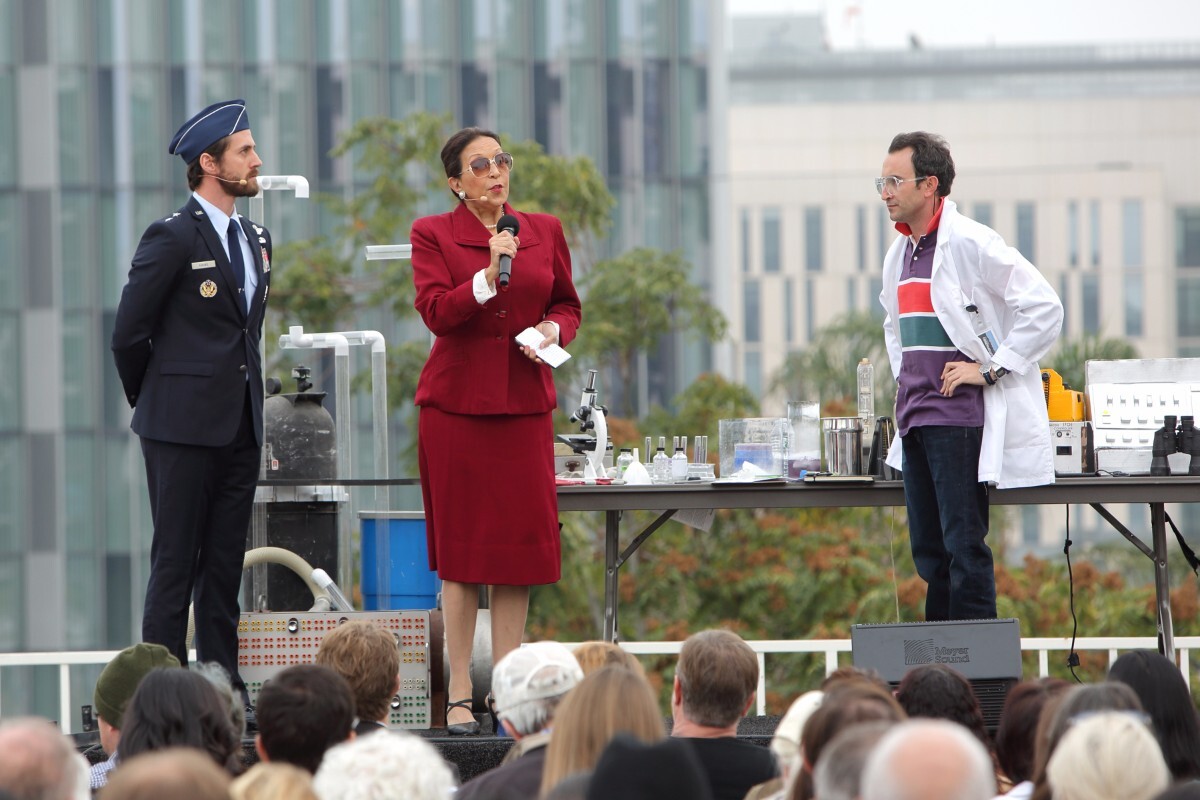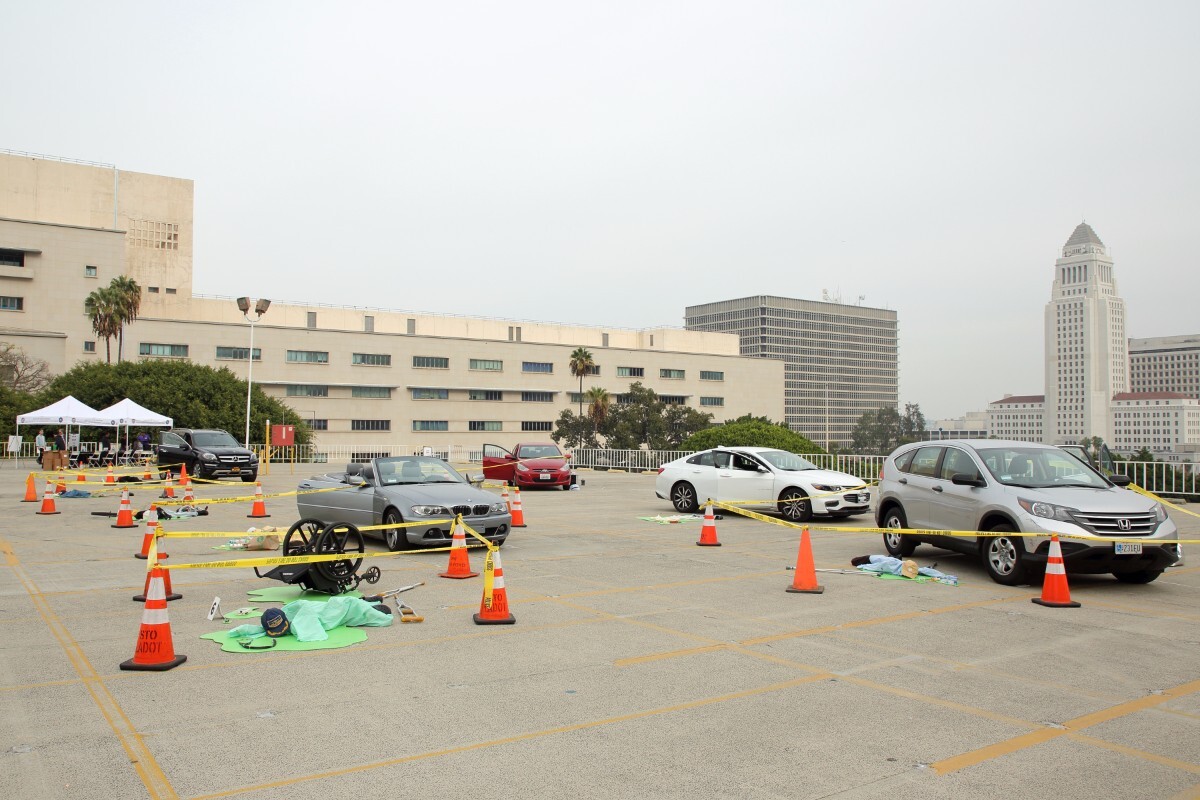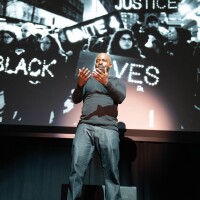'War of the Worlds' for the 21st Century Takes Over Downtown Los Angeles

It might have been one of the earlier disseminations of fake news, if, that is, the October 30, 1938 radio broadcast of “War of the Worlds,” hadn’t already been a dramatization of H.G. Wells’ 1898 novel of the same name. Chalk it up to wunderkind Orson Welles, 23 at the time, who with his band of actors from Mercury Theatre on the Air, offered a documentary-like portrayal of Martians invading America, with the first spaceships landing in, of all places, New Jersey.
What ensued was mass hysteria, with terrified listeners stampeding from their homes into the streets and reports of suicide flooding hospital switchboards everywhere. Anxiety-ridden, the country was still in the midst of the Depression and also on the brink of World War II with the rise of Hitler. It wasn’t surprising, then, that this one-hour radio play took its listeners by metaphorical storm.
Now, nearly 80 years after that iconic broadcast, Yuval Sharon, founder and artistic director of The Industry, the company devoted to new and experimental opera, has brought his radical adaptation of the play to Walt Disney Concert Hall and the streets of downtown Los Angeles (November 12 and 18).
Using the original radio script as the basis of this bold new performance piece, Sharon invited Annie Gosfield to compose the score, with Christopher Rountree (of wild Up fame) conducting the LA Phil New Music Group. With some 25 musicians performing at the Hall - instrumentation includes Theremin, celesta and sampling — the score was broadcast through three refurbished WWII-era sirens that have been reactivated for two-way communication. Onsite musicians included multiple percussionists, a cellist, violinist and bassist, with performers sending their reports of alien invasion back to Disney Hall.
Narrated by actor Sigourney Weaver, this “War” opened with a brass raucousness that vacillated between a “Twilight Zone”-like two-note motif and static radio sounds. Rountree led the ensemble with sweeping gestures, evoking, at times, a celestial, er, one might even say, extra-terrestrial quality reminiscent of Lalo Schiffrin’s “Mission Impossible” theme, with Mark Kashper leading an intense string section that could feel at home in any Bernard Herrmann score.

But the cacophony had just begun when Weaver alerted the audience to breaking news, explaining that “we may need to evacuate,” though there was “no need to panic.” There was great interplay between Weaver and the singers at the three siren sites, when a convincing Mayor Eric Garcetti made a surprise appearance at the Hall, assuring us that even though Martians had landed, the citizens of L.A. would prevail.
Supertitles were projected on screens in the concert venue, with the most striking visuals — and an otherworldly sonic landscape — coming from the astonishing Hila Plitmann as La Sirena who, with Joanne Pearce Martin on Theremin/sampler and Matthew Howard credited with percussion for live foley, performed from a riser at the rear of the stage, Pablo Santiago’s lush lighting adding to the atmosphere.

A cross between the late Peruvian songbird, Yma Sumac, scat specialist Ella Fitzgerald and Lady Gaga, Plitmann rocked a skin-tight red dress that was in contrast to her silver-painted face, neck and arms as she reached for glass-shattering notes, gurgling, trilling and writhing as if possessed.
A lone siren speaker — a yellow metal cylinder — hung from the ceiling as the audience was cautioned to “avoid the 110,” after gas masks were deemed “useless in Van Nuys.” The sold-out crowd, in addition to finding humor in Sharon’s narrative, also appreciated its relevancy (mezzo-soprano Suzanna Guzmán talked/sang of “undocumented aliens” from Siren Site 2), and at the opera’s end — hint: Frank Gehry’s Disney Hall, by dint of its titanium-like skin, kept us safe from deadly “heat rays” — music was triumphant in this profoundly ingenious endeavor.
If all of this sounds a bit heady, it’s in keeping with the New York Times’ description of Sharon as “opera’s disrupter in residence,” meaning he’s the man who brought opera into 24 limousines (“Hopscotch,” 2015), L.A.’s Union Station (the 2013 “headphone” opera “Invisible Cities”), and to various “non-spaces,” such as warehouses, parking lots, and escalator corridors.
But tackling “War of the Worlds” would seem a daunting project, even for Sharon, as Welles not only directed the drama and voiced the narrator, Professor Richard Pierson, becoming an overnight sensation in the process, but because of its logistical challenges.
“Orson Welles is one of my heroes,” said Sharon, who was recently honored with a 2017 MacArthur Fellowship, “so I knew a lot about “War of the Worlds” and his pre-Hollywood career before he switched mediums to film. But one of my chief inspirations came from the WWII sirens out on the street.”
In fact, it was Tanner Blackman, former planning director for councilmember José Huizar and Carmen Zella, artistic director of NOW Art LA, a public arts organization that is also a co-producer of “War of the Worlds,” who had investigated the history of the 276 air raid sirens scattered throughout town, and conceived the vision to repurpose them into a sound art network. Sharon, who learned of the sirens from Blackman at about the same time the LA Phil tapped him for a three-year residency (his appointment began in 2016), immediately understood how to make the concert hall experience pour onto the streets of downtown L.A.
“In “Hopscotch” I was thinking about how to connect these disparate sites through this musical experience,” recalled Chicago-born Sharon, “and how these sirens offer another opportunity of simultaneity — the bringing together of different sites into a harmony. We have dialogues [live-streaming], between the Hall and the sites, and that’s what is technologically pretty astonishing.
“The singers at the sites play multiple characters and are going to be moving by car from siren to siren,” added Sharon, 38. “They have their own kind of relay race that is similar to “Hopscotch.” So when you see this project, you’ll start noticing the sirens, and audiences will be asking themselves about the history of the streets they live on, which was the goal of “Hopscotch” — to question and be curious about the landscape around us, not be numb to it as we drive through. The psycho-geographic mission is the pursuit of ideas that are embedded into the landscape around us.”
“War” is Sharon’s first libretto, though strictly speaking, it is an adaptation of the 1938 script that was written by Howard Koch, who co-wrote the film classic “Casablanca.” The drama featured a series of simulated news bulletins, and more than a dozen actors screaming in abject terror, speechifying presidential-style and offering highly-charged emotional reportage. But nobody involved with the original production thought that they would be deceiving listeners, having found the story too preposterous to believe.
Radio also proved to be an important influence on the work for Gosfield, who calls New York home and hadn’t yet tackled opera. Sharon had known of her music when he lived in New York and worked at the New York City Opera, leading its VOX program for new operas about ten years ago, but the two had never met.
That changed in March of last year, when a Green Umbrella concert featured Gosfield’s “Refracted Reflections and Telepathic Static,” prompting Chad Smith, COO of the LA Phil, to suggest Gosfield might be right for this project. Sharon agreed, and a collaboration was born.
Gosfield, whose use of radio sounds has been a constant in her work, combines electronics with acoustic sounds, largely, she says, “because my music is influenced by non-musical sources – radio noise, machine noise. And I’m open to my environment, which makes for unusual amalgamations of sound in music. I don’t mean noise as a genre, but sounds, like radio static.
“I studied the 1938 broadcast,” she continued, “which has these great precedents. A lot of it is concerts being broadcast from different ballrooms playing bad dance music. There is also a sense of things shifting, from report to report and location to location.”
Scroll left or right below to see more photos from the first performance of "War of the Worlds."


















It’s doubtful that the audiences of 2017 will react the way radio listeners did in 1938, with a Princeton University study estimating that of the approximately 6 million people who listened to the original broadcast, more than 1million took it literally, while an unknown number who had not even tuned in was caught up in the general delirium.
But with talk of fake news rampant in today’s political climate, this “War of the Worlds” is sure to strike a chord with concertgoers whose feelings of malaise, discontent and fear also seem to be reverberating in their everyday lives.
“When Yuval and I were originally talking about it,” said Gosfield, “we had no idea that fake news was going to be such a huge issue. There are a lot of subjects we deal with that are fake news, about immigrants — which is another thing we didn’t expect to be such a burning issue in 2017 — this feeling that your country is being overtaken by aliens. I was reading H.G. Wells, dutifully, but I had to put it down. It was a bit too much because of what’s happened politically in our country.”
The project has actually become more relevant than either Sharon or Gosfield, whom the New Yorker dubbed, “New York’s doyenne of random sampled sounds,” had initially envisioned.
“My mother, who is 88, remembers the radio broadcast airing,” said the composer. “She was in Brooklyn playing stickball in the street with her friends, and a group of mothers came out telling everyone to come inside, that ‘something’s happening.’ She remembers all the windows opening and people calling their kids home.
“There has also been fake news about “War of the Worlds” — that it was not as sensational as it was,” Gosfield, 57, pointed out. “The time was not dissimilar to now. People were used to radio bulletins and there had been some terrible natural disasters — hurricanes weeks before - and not everybody processed the fact that they were reporting on an alien attack.”
That the radio drama seemed credible exceeded the expectations of all involved. Indeed, what journalists wanted to know after the 1938 broadcast was one basic question: Had Welles planned this as deception or was he truly surprised at the broadcast’s aftermath?
Sharon maintains that Welles did not intend to panic his audience. “I think you can see that on his face in a television interview with him directly after the broadcast. He is unusually jumpy and unsettled. A. Brad Schwartz gives a terrific account of the history of the broadcast in his [2015] book, “Broadcast Hysteria: Orson Welles's War of the Worlds and the Art of Fake News.” It was,” added Sharon, “my first resource in adapting the original radio drama.”
The director also admits that between the time of conception and today’s reality, the piece took a turn. “It became quite different, and it’s been great to see this project morph in relation to this crisis we’re in — socially and politically. Here’s a piece that can directly address the fears we’re all facing today.”
But for Sharon, it’s always been more about the journey than the destination. “The reception of the work is not my consideration,” he pointed out. “It’s the journey that pushes the limits of what’s been attempted until now. It’s about that process of creating — much more than the impact, which is out of my control. That’s up to the audience — how they understand it or not, how appropriate it is or not, what is the level of good taste — to be creating a piece about fake news.”
The two final performances of "War of the Worlds" will be on November 18 at noon and 2 p.m.



